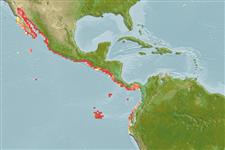Environment: milieu / Klimaatzone / Diepte / distribution range
Ecologie
marien demersaal; diepte 1 - 100 m (Ref. 96339). Tropical; 32°N - 7°S, 115°W - 78°W (Ref. 114953)
Eastern Pacific: Gulf of California to northern Peru.
Grootte / Gewicht / Leeftijd
Maturiteit: Lm ? range ? - ? cm
Max length : 119 cm TL mannelijk / geslacht onbekend; (Ref. 111131)
Found in shallow water on sandy bottoms, sometimes adjacent to reefs (Ref. 12951). Found buried in the sand during the day (Ref. 12951). Moves into shallow bays at night to feed; prefers polychaete worms, but may take sea squirts (Ref. 12951). Produces litters of up to 15 pups. Maturity size of males at ca. 36 cm TL; birth size at ca. 11 cm TL (Ref. 114953).
Levenscyclus en paargedrag
Maturiteit | Voortplanting | Paaien | Eieren | Fecunditeit | Larven
McEachran, J.D., 1995. Narcinidae. Rayas eléctricas. p. 769-771. In W. Fischer, F. Krupp, W. Schneider, C. Sommer, K.E. Carpenter and V. Niem (eds.) Guia FAO para Identification de Especies para los Fines de la Pesca. Pacifico Centro-Oriental. 3 Vols. FAO, Rome. (Ref. 9259)
Status op de Rode Lijst van het IUCN (Ref. 130435: Version 2025-1)
Gebruik door de mens
Tools
Speciale rapporten
Download XML
Internetbronnen
Estimates based on models
Preferred temperature (Ref.
123201): 18.5 - 28.9, mean 25.8 °C (based on 82 cells).
Fylogenetische diversiteitsindex (Ref.
82804): PD
50 = 0.5000 [Uniqueness, from 0.5 = low to 2.0 = high].
Bayesian length-weight: a=0.01259 (0.00719 - 0.02203), b=2.90 (2.74 - 3.06), in cm total length, based on LWR estimates for this species & (Sub)family-body (Ref.
93245).
Trofisch niveau (Ref.
69278): 3.0 ±0.18 se; based on food items.
Weerstandsvermogen (Ref.
120179): laag, minimale populatieverdubbelingstijd 4,5-14 jaar (Assuming fecundity<100).
Fishing Vulnerability (Ref.
59153): High to very high vulnerability (71 of 100).
🛈
